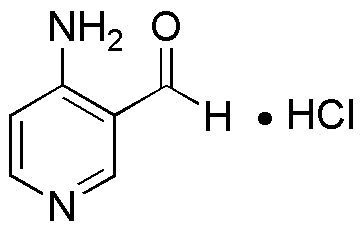3-Formyl-pyridin-4-ylamine·HCl is widely utilized in research focused on:
- Synthetic Chemistry: This compound serves as a key intermediate in the synthesis of various pharmaceutical agents, enabling researchers to develop new drugs with improved efficacy.
- Biochemical Studies: It is used in the study of enzyme inhibitors, particularly in the development of treatments for diseases like cancer, where targeting specific enzymes is crucial.
- Material Science: The compound can be incorporated into polymers or coatings, enhancing their properties such as thermal stability and chemical resistance, which is beneficial for industrial applications.
- Analytical Chemistry: It acts as a reagent in analytical methods, helping to detect and quantify other substances in complex mixtures, which is essential for quality control in manufacturing.
- Medicinal Chemistry: The compound's unique structure allows it to interact with biological targets, making it a valuable candidate for drug discovery and development in the pharmaceutical industry.
General Information
Properties
Safety and Regulations
Applications
3-Formyl-pyridin-4-ylamine·HCl is widely utilized in research focused on:
- Synthetic Chemistry: This compound serves as a key intermediate in the synthesis of various pharmaceutical agents, enabling researchers to develop new drugs with improved efficacy.
- Biochemical Studies: It is used in the study of enzyme inhibitors, particularly in the development of treatments for diseases like cancer, where targeting specific enzymes is crucial.
- Material Science: The compound can be incorporated into polymers or coatings, enhancing their properties such as thermal stability and chemical resistance, which is beneficial for industrial applications.
- Analytical Chemistry: It acts as a reagent in analytical methods, helping to detect and quantify other substances in complex mixtures, which is essential for quality control in manufacturing.
- Medicinal Chemistry: The compound's unique structure allows it to interact with biological targets, making it a valuable candidate for drug discovery and development in the pharmaceutical industry.
Documents
Safety Data Sheets (SDS)
The SDS provides comprehensive safety information on handling, storage, and disposal of the product.
Product Specification (PS)
The PS provides a comprehensive breakdown of the product’s properties, including chemical composition, physical state, purity, and storage requirements. It also details acceptable quality ranges and the product's intended applications.
Certificates of Analysis (COA)
Search for Certificates of Analysis (COA) by entering the products Lot Number. Lot and Batch Numbers can be found on a product’s label following the words ‘Lot’ or ‘Batch’.
*Catalog Number
*Lot Number
Certificates Of Origin (COO)
This COO confirms the country where the product was manufactured, and also details the materials and components used in it and whether it is derived from natural, synthetic, or other specific sources. This certificate may be required for customs, trade, and regulatory compliance.
*Catalog Number
*Lot Number
Safety Data Sheets (SDS)
The SDS provides comprehensive safety information on handling, storage, and disposal of the product.
DownloadProduct Specification (PS)
The PS provides a comprehensive breakdown of the product’s properties, including chemical composition, physical state, purity, and storage requirements. It also details acceptable quality ranges and the product's intended applications.
DownloadCertificates of Analysis (COA)
Search for Certificates of Analysis (COA) by entering the products Lot Number. Lot and Batch Numbers can be found on a product’s label following the words ‘Lot’ or ‘Batch’.
*Catalog Number
*Lot Number
Certificates Of Origin (COO)
This COO confirms the country where the product was manufactured, and also details the materials and components used in it and whether it is derived from natural, synthetic, or other specific sources. This certificate may be required for customs, trade, and regulatory compliance.


